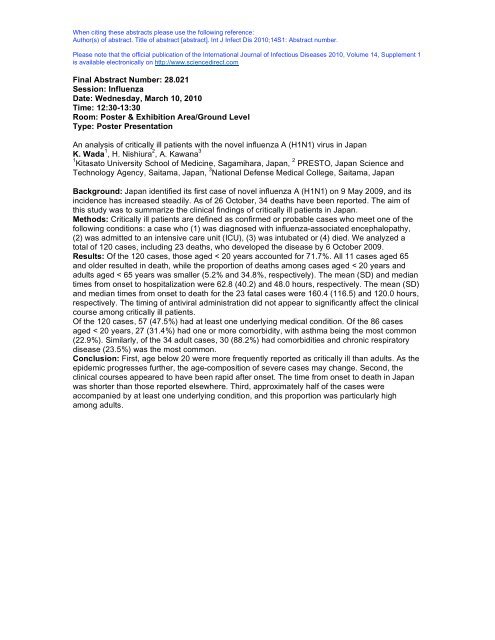14th ICID - Poster Abstracts - International Society for Infectious ...
14th ICID - Poster Abstracts - International Society for Infectious ...
14th ICID - Poster Abstracts - International Society for Infectious ...
You also want an ePaper? Increase the reach of your titles
YUMPU automatically turns print PDFs into web optimized ePapers that Google loves.
When citing these abstracts please use the following reference:<br />
Author(s) of abstract. Title of abstract [abstract]. Int J Infect Dis 2010;14S1: Abstract number.<br />
Please note that the official publication of the <strong>International</strong> Journal of <strong>Infectious</strong> Diseases 2010, Volume 14, Supplement 1<br />
is available electronically on http://www.sciencedirect.com<br />
Final Abstract Number: 28.021<br />
Session: Influenza<br />
Date: Wednesday, March 10, 2010<br />
Time: 12:30-13:30<br />
Room: <strong>Poster</strong> & Exhibition Area/Ground Level<br />
Type: <strong>Poster</strong> Presentation<br />
An analysis of critically ill patients with the novel influenza A (H1N1) virus in Japan<br />
K. Wada 1 , H. Nishiura 2 , A. Kawana 3<br />
1 Kitasato University School of Medicine, Sagamihara, Japan, 2 PRESTO, Japan Science and<br />
Technology Agency, Saitama, Japan, 3 National Defense Medical College, Saitama, Japan<br />
Background: Japan identified its first case of novel influenza A (H1N1) on 9 May 2009, and its<br />
incidence has increased steadily. As of 26 October, 34 deaths have been reported. The aim of<br />
this study was to summarize the clinical findings of critically ill patients in Japan.<br />
Methods: Critically ill patients are defined as confirmed or probable cases who meet one of the<br />
following conditions: a case who (1) was diagnosed with influenza-associated encephalopathy,<br />
(2) was admitted to an intensive care unit (ICU), (3) was intubated or (4) died. We analyzed a<br />
total of 120 cases, including 23 deaths, who developed the disease by 6 October 2009.<br />
Results: Of the 120 cases, those aged < 20 years accounted <strong>for</strong> 71.7%. All 11 cases aged 65<br />
and older resulted in death, while the proportion of deaths among cases aged < 20 years and<br />
adults aged < 65 years was smaller (5.2% and 34.8%, respectively). The mean (SD) and median<br />
times from onset to hospitalization were 62.8 (40.2) and 48.0 hours, respectively. The mean (SD)<br />
and median times from onset to death <strong>for</strong> the 23 fatal cases were 160.4 (116.5) and 120.0 hours,<br />
respectively. The timing of antiviral administration did not appear to significantly affect the clinical<br />
course among critically ill patients.<br />
Of the 120 cases, 57 (47.5%) had at least one underlying medical condition. Of the 86 cases<br />
aged < 20 years, 27 (31.4%) had one or more comorbidity, with asthma being the most common<br />
(22.9%). Similarly, of the 34 adult cases, 30 (88.2%) had comorbidities and chronic respiratory<br />
disease (23.5%) was the most common.<br />
Conclusion: First, age below 20 were more frequently reported as critically ill than adults. As the<br />
epidemic progresses further, the age-composition of severe cases may change. Second, the<br />
clinical courses appeared to have been rapid after onset. The time from onset to death in Japan<br />
was shorter than those reported elsewhere. Third, approximately half of the cases were<br />
accompanied by at least one underlying condition, and this proportion was particularly high<br />
among adults.
















